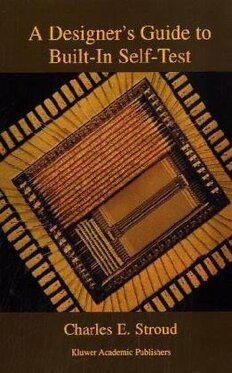Download A Designer’s Guide to Built-In Self-Test PDF Free - Full Version
Download A Designer’s Guide to Built-In Self-Test by Charles E. Stroud (auth.) in PDF format completely FREE. No registration required, no payment needed. Get instant access to this valuable resource on PDFdrive.to!
About A Designer’s Guide to Built-In Self-Test
A recent technological advance is the art of designing circuits to test themselves, referred to as a Built-In Self-Test (BIST). This idea was first proposed around 1980 and has grown to become one of the most important testing techniques at the current time, as well as for the future. This book is written from a designer's perspective and describes the major BIST approaches that have been proposed and implemented since 1980, along with their advantages and limitations. The BIST approaches include the Built-In Logic Block Observer, pseudo-exhaustive BIST techniques, Circular BIST, scan-based BIST, BIST for regular structures, BIST for FPGAs and CPLDs, mixed-signal BIST, and the integration of BIST with concurrent fault detection techniques for on-line testing. Particular attention is paid to system-level use of BIST in order to maximize the benefits of BIST through reduced testing time and cost as well as high diagnostic resolution. The author spent 15 years as a designer at Bell Labs where he designed over 20 production VLSI devices and 3 production circuit boards. Sixteen of the VLSI devices contained BIST of various types for regular structures and general sequential logic, including the first BIST for Random Access Memories (RAMs), the first completely self-testing integrated circuit, and the first BIST for mixed-signal systems at Bell Labs. He has spent the past 10 years in academia where his research and development continues to focus on BIST, including the first BIST for FPGAs and CPLDs along with continued work in the area of BIST for general sequential logic and mixed-signal systems. He holds 10 US patents (with 5 more pending) for various types of BIST approaches. Therefore, the author brings a unique blend of knowledge and experience to this practical guide for designers, test engineers, product engineers, system diagnosticians, and managers.
Detailed Information
| Author: | Charles E. Stroud (auth.) |
|---|---|
| Publication Year: | 2002 |
| ISBN: | 306475049 |
| Pages: | 340 |
| Language: | English |
| File Size: | 14.408 |
| Format: | |
| Price: | FREE |
Safe & Secure Download - No registration required
Why Choose PDFdrive for Your Free A Designer’s Guide to Built-In Self-Test Download?
- 100% Free: No hidden fees or subscriptions required for one book every day.
- No Registration: Immediate access is available without creating accounts for one book every day.
- Safe and Secure: Clean downloads without malware or viruses
- Multiple Formats: PDF, MOBI, Mpub,... optimized for all devices
- Educational Resource: Supporting knowledge sharing and learning
Frequently Asked Questions
Is it really free to download A Designer’s Guide to Built-In Self-Test PDF?
Yes, on https://PDFdrive.to you can download A Designer’s Guide to Built-In Self-Test by Charles E. Stroud (auth.) completely free. We don't require any payment, subscription, or registration to access this PDF file. For 3 books every day.
How can I read A Designer’s Guide to Built-In Self-Test on my mobile device?
After downloading A Designer’s Guide to Built-In Self-Test PDF, you can open it with any PDF reader app on your phone or tablet. We recommend using Adobe Acrobat Reader, Apple Books, or Google Play Books for the best reading experience.
Is this the full version of A Designer’s Guide to Built-In Self-Test?
Yes, this is the complete PDF version of A Designer’s Guide to Built-In Self-Test by Charles E. Stroud (auth.). You will be able to read the entire content as in the printed version without missing any pages.
Is it legal to download A Designer’s Guide to Built-In Self-Test PDF for free?
https://PDFdrive.to provides links to free educational resources available online. We do not store any files on our servers. Please be aware of copyright laws in your country before downloading.
The materials shared are intended for research, educational, and personal use in accordance with fair use principles.

